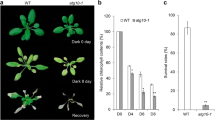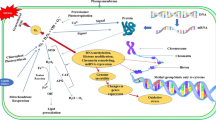Summary
The cytoarchitecture and the pattern of cytoplasmic streaming change during the development of root hairs ofMedicago truncatula and after a challenge with nodulation (Nod) factors. We measured the speed and orientation of movement of 1–2 μm long organelles. The speed of organelle movement in cytoplasmic strands in the basal part of growing root hairs is 8–14 μm/s and is of the circulation type like in trichoblasts, bulges before tip-growth initiation, and full-grown hairs. In the subapical area of growing hairs, reverse-fountain streaming occurs discontinuously at a slower net speed. The reason for the slower speed is the fact that organelles often stop and jump. Reverse-fountain streaming is a pattern in which the main direction of organelle transport reverses 180 degrees before the cell tip is reached. Within minutes after their application to roots,Rhizobium leguminosarum-derived Nod factors, cause an increase and divergence in the subapical cytoplasmic strands. This phenomenon can best be observed in the growth-terminating hairs, since in hairs of this developmental stage, subapical cytoplasmic strands are transvacuolar. First, the tips of these hairs swell. The organelle movement in the swelling tip increases up to the level normal for circulation streaming, and the number of strands with moving organelles increases. When a new polar outgrowth emerges, reverse-fountain streaming is set up again, with all its characteristics like those seen in growing hairs. This outgrowth may obtain a new full root hair length, by which these hairs may become twice as long as nonchallenged hairs.
Similar content being viewed by others
Abbreviations
- DIG:
-
differential interference contrast
- LCO:
-
lipochito-oligosaccharide
- FESEM:
-
field emission scanning electron microscopy
- VEC:
-
microscopy video enhanced-contrast microscopy
References
Allen NS, Bennett MN (1996) Electro-optical imaging of f-actin and endoplasmic reticulum in living and fixed plant cells. Scanning Microsc Suppl 10: 177–187
De Ruijter NCA, Rook MB, Bisseling T, Emons AMC (1998) Lipochitooligosaccharides reinitiate root hair tip growth inVicia sativa with high calcium and spectrin-like antigen at the tip. Plant J 13: 341–350
—, Bisseling T, Emons AMC (1999) Rhizobium Nod factors induce an increase in sub-apical fine bundles of actin filaments inVicia sativa root hairs within minutes. Mol Plant Microbe Interact 12: 829–832
De Win AHN (1997) Quantitative analyses of organelle movements in pollen tubes. PhD thesis, Catholic University of Nijmegen, Nijmegen, the Netherlands
Dolan L, Duckett CM, Grierson C, Linstead P, Schneider K, Lawson E, Dean C, Poethig S, Roberts K (1994) Clonal relationships and cell patterning in the root epidermis ofArabidopsis. Development 120: 2465–2474
Emons AMC (1987) The cytoskeleton and secretory vesicles in root hairs ofEquisetum andLimnobium and cytoplasmic streaming in root hairs ofEquisetum. Ann Bot 60: 625–632
—, Mulder B (2000) Nodulation factors trigger an increase of fine bundles of subapical filaments inVicia root hairs: implications for root hair curling around bacteria. In: De Wit PJGM, Bisseling T, Stiekema W (eds) Biology of plant-microbe interaction, vol 2. International Society of Molecular Plant-Microbe Interactions, St. Paul, Minn, pp 272–276
—, Wolters-Arts AMC (1983) Cortical microtubules and microfibril deposition in the cell wall of root hairs ofEquisetum hyemale. Protoplasma 117: 68–81
Esseling J, De Ruijter NCA, Emons AMC (2000) The root hair actin cytoskeleton as backbone, highway, morphogenetic instrument and target for signaling. In: Ridge RW, Emons AMC (eds) Cell and molecular biology of plant root hairs. Springer, Berlin Tokyo, pp 29–52
Fåhraeus G (1957) The infection of white clover root hairs by nodule bacteria studied by a simple glass slide technique. J Gen Microbiol 16: 374–381
Haberlandt G (1887) Function und Lage des Zellkernes bei den Pflanzen. Gustav Fischer, Jena
Heidstra R, Geurts R, Franssen H, Spaink HP, van Kammen A, Bisseling T (1994) Root hair deformation activity of nodulation factors and their fate onVicia sativa. Plant Physiol 105: 787–797
Iwanami Y (1956) Protoplasmic movement in pollen grains and tubes. Phytomorphology 6: 288–295
Jarosch R (1956) Plasmaströmung und Chloroplastenrotation bei Characeen. Phyton (Horn, Austria) 6: 87–107
Kamiya N (1959) Protoplasmic streaming. Springer, Wien (Heilbrunn LV, Weber F [eds] Protoplasmatologia, vol VIII, 3, a)
—, Kuroda K (1958) Measurement of the motive force of the protoplasmic rotation inNitella. Protoplasma 50: 144–148
Kijne JW (1992) The rhizobium infection process. In: Stacey G, Burris RH, Evans HJ (eds) Biological nitrogen fixation. Chapman and Hall, New York, pp 349–398
Leavitt RG (1904) Trichomes of the root in vascular cryptogams and angiosperms. Proc Boston Soc Nat Hist 31: 273–313
Lichtscheidl IK (1995) Organelle motility in plant cells:Allium cepa inner epidermis. Wiss Film 47: 111–125
—, Foissner I (1996) Video microscopy of dynamic plant cell organelles: principles of the technique and practical application. J Microsc 181: 117–128
Miller DD, De Ruijter NCA, Emons AMC (1997) From signal to form: aspects of the cytoskeleton-plasma membrane-cell wall continuum in root hair tips. J Exp Bot 48: 1881–1896
— —, Bisseling T, Emons AMC (1999) The role of actin in root hair morphogenesis: studies with lipochito-oligosaccharide as a growth stimulator and cytochalasin as an actin perturbing drug. Plant J 17: 101–113
Schwarz F (1883) Die Wurzelhaare der Pflanzen: ein Beitrag zur Biologie und Physiologie dieser Organe. Untersuch Bot Inst Tübingen 1: 135–188
Tominaga M, Sonobe S, Shimmen T (1998) Mechanism of inhibition of cytoplasmic streaming by auxin in root hair cells ofHydrocharis. Plant Cell Physiol 39: 1342–1349
Von Guttenberg H (1968) Der primäre Bau der Angiospermenwurzel. In: Zimmermann W, Ozenda P, Wulff D (eds) Handbuch der Pflanzenanatomie VIII, 5. Borntraeger, Berlin Stuttgart, p 115
Williamson RE (1992) Cytoplasmic streaming in characean algae: mechanisms, regulation by Ca2+ and organization. In: Melkonian M (ed) Algal cell motility. Chapman and Hall, London, pp 73–98
Author information
Authors and Affiliations
Corresponding author
Additional information
Dedicated to Professor Walter Gustav Url on the occasion of his 70th birthday
Rights and permissions
About this article
Cite this article
Sieberer, B., Emons, A.M.C. Cytoarchitecture and pattern of cytoplasmic streaming in root hairs ofMedicago truncatula during development and deformation by nodulation factors. Protoplasma 214, 118–127 (2000). https://doi.org/10.1007/BF02524268
Received:
Accepted:
Issue Date:
DOI: https://doi.org/10.1007/BF02524268




